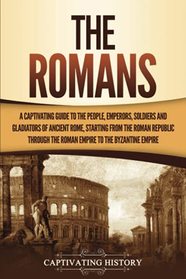This starts with the earliest days of Rome (while there were kingdoms) and continues for about 2000+ years. The Etruscans and the Latins commingled; two of the early Roman kings were Etruscans. By 500 BCE, Rome had developed an urban city with a protective wall around it and a system of religious rituals. The kings were no more and the citizens' public meetings controlled their consul (magistrate); who would rule one year.
This overview was more interesting than a summary of battles because it explained the role of the citizens, how the gods ruled the world (through the interpretation of the augers, who understood the will of the gods), and how they fended off their enemies (they had agreements to assist each other when threatened). An interesting comment by the author is that after Rome took a city, they made alliances and agreements that benefitted both parties. The Romans administered, but the locals controlled their identity and social policies. A portion of the newly acquired citizens (young men) were conscripted into the legions. This was a completely new model of ruling a vanquished foe.
When Rome absorbed non-Latin areas, their rules were different. This book explains how Rome changed and flexed their muscle as times changed. Usually, Captivating History does an in-depth study of individual rulers; this one, by looking at the changes brought by each ruler, showed the flow and ebb of the Roman Empire.
By 235 CE, Rome was devolving into a mess. The emperor no longer controlled the country, collecting taxes and paying the army. The borders were no longer secure and controlled. The tradition of military leaders from the wealthy classes no longer held. The only ruler was insanity; inflation raged across the land. Then barbarians were at the gates of Rome.
I really enjoyed this book because readers got a serious look at the lives of the Romans, their incredible roads, their entertainments (gladiators, etc.), and the incredible broad sweep of their history, the highs, and the lows.
This overview was more interesting than a summary of battles because it explained the role of the citizens, how the gods ruled the world (through the interpretation of the augers, who understood the will of the gods), and how they fended off their enemies (they had agreements to assist each other when threatened). An interesting comment by the author is that after Rome took a city, they made alliances and agreements that benefitted both parties. The Romans administered, but the locals controlled their identity and social policies. A portion of the newly acquired citizens (young men) were conscripted into the legions. This was a completely new model of ruling a vanquished foe.
When Rome absorbed non-Latin areas, their rules were different. This book explains how Rome changed and flexed their muscle as times changed. Usually, Captivating History does an in-depth study of individual rulers; this one, by looking at the changes brought by each ruler, showed the flow and ebb of the Roman Empire.
By 235 CE, Rome was devolving into a mess. The emperor no longer controlled the country, collecting taxes and paying the army. The borders were no longer secure and controlled. The tradition of military leaders from the wealthy classes no longer held. The only ruler was insanity; inflation raged across the land. Then barbarians were at the gates of Rome.
I really enjoyed this book because readers got a serious look at the lives of the Romans, their incredible roads, their entertainments (gladiators, etc.), and the incredible broad sweep of their history, the highs, and the lows.




